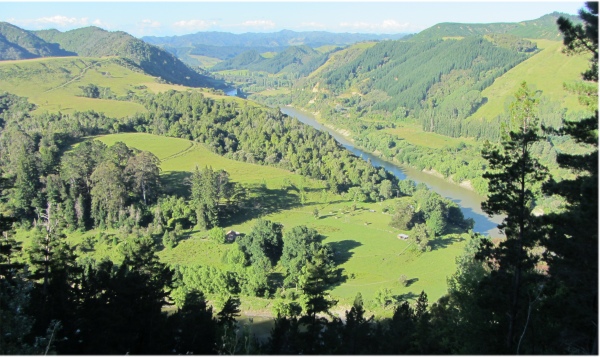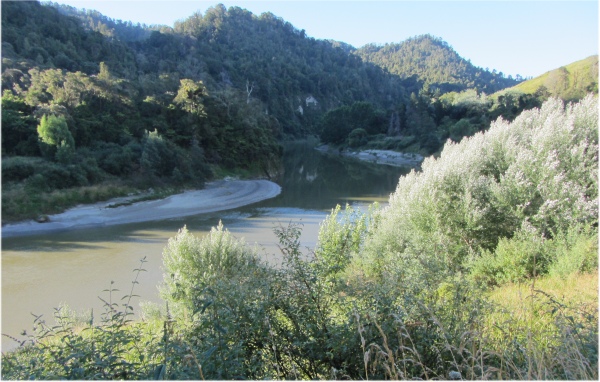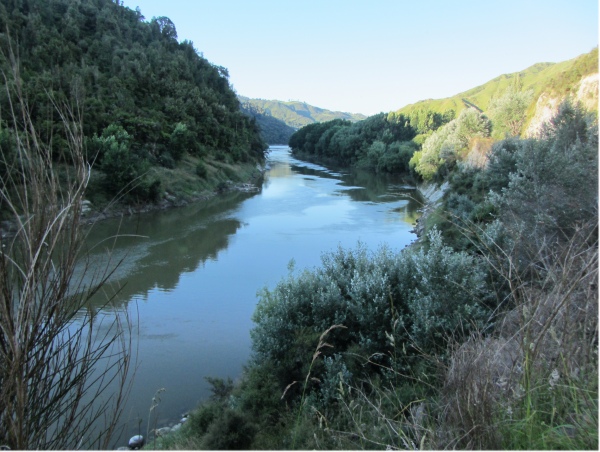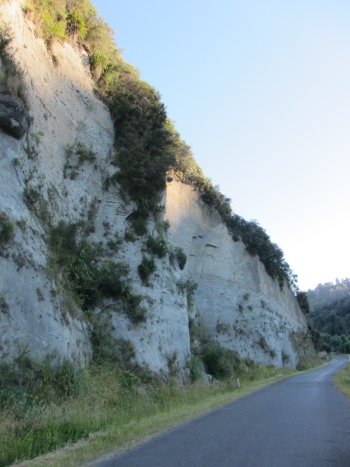 Whanganui River Lookout |
I arose eventually, had breakfast, and just before I was about to do my laundry, I passed by a couple who I wished Merry Christmas to. I was greeted like a long lost son, and soon I was chatting away to Roger and Fay. The Kiwi couple were both retired and travelling around the North Island over Christmas. They both used to run a general store over near Gisborne, did farm work for a while, before Roger started working in a livestock delivery company and Fay started in a hospice. They were now retired, but Roger still did casual work for the same company, quite lucrative by the sounds of it, and Fay did voluntary work with the hospice.
They enjoyed travelling around in their large motor-home. "Do you make a big trip each year?" I asked. "Hell no," replied Roger, whose language could be colourful at times, "we take a week out every month." Fay loved to travel abroad, but Roger preferred to stick to New Zealand. He made a concession, and they were off to Australia in April.
 Whanganui River Bend |
We discussed families at length; it is amazing how much we confide in total strangers, and analysed our country's ailments. New Zealand has a mounting debt, and is digging a large hole for itself by conceding many land rights to the Maori. I won't go into that. Fay's brother, who must be well into his 60s, had acquired a wife from Singapore, complete with miniskirt, a boobtube, and stilettos, and seemed to be living the life of Riley, and the gossip went on. We had lunch together on the campsite, a simple salad, but that was all that was required on this scorching day. We must have spent about four hours just chatting together.
 Whanganui River Stretch |
But they were expecting company, and I had my laundry to do, so we wished each other Merry Christmas and went about our separate businesses. They had been good and amusing company.
Once laundry was done, I took my beard trimmer apart, reassembled it, and that seemed to make it work. I met a chap by the small swimming pool, who was keeping his eye on his two sons who were content to jump in the water, get out and jump in again, ad infinitum. He was here, with umpteen other motorcyclists now gathered at the site, to watch the Whanganui Bikes Races the next day. Apparently these races have been going for 60 years now, are well known and televised. He hailed from Blenheim on the South Island, which sits on a fault line. A rather comforting thought knowing that Christchurch, that doesn't sit on a fault line, had a couple more earthquakes a couple of days ago. He gave me some good pointers for my tour of the South Island, and both he, Roger and Fay reckoned there should be no problem getting ferry tickets at all.
By now it was 6pm, and I hadn't achieved what I had hoped to do today, drive up by the Whanganui River as far as Pipiriki. While it was still hot with the sun a fair way above the horizon, I set off and drove into the Whanganui National Park and followed the river road..
The Whanganui National Park is based around New Zealand's longest navigable river, the Whanganui, which rises on Mt Tongariro and winds its way 329 km to the Tasman Sea. The upper reaches are wrapped in a dense mantle of forest, spread over an endless succession of razorback ridges that are largely road less and trackless. The park is at the centre of a large sedimentary basin, so the rocks are mostly soft sandstone and mudstones; easily sculpted by the river into fascinating shapes, deep gorges, sharp ridges, sheer cliffs and waterfalls. Cloaked in dense rainforest, the National Park has one of the largest remaining tracts of intact native lowland forest in the North Island. Tree ferns and rare native plants clutch the steep riverbanks and morning mist clings to the surface of the water from dawn, rising slowly with the light of day.
 Whanganui River Cliffs |
Until recent times, the Whanganui River was the main route into the interior of the North Island and its fascinating history is riddled with legends of steamboats and wars, water-powered flour mills and poets, the mysterious Bridge to Nowhere, and abandoned homes and farms. It has always been an important communication route to the interior, initially for Maori canoes and latter for the famous series of river boats run by Hatrick & Co. The river was one of the most challenging in the world for regular navigation with the river boats traversing 239 rapids in the journey from Whanganui to Taumarunui in King Country. The term King Country comes from the trouble in the 1860s when there was some dissent over the way the Treaty of Waitangi was working out, and the Maoris elected their own King in the area which became virtually a no-go area for Pakeha until late in the century. By the time the river was opened up for navigation by Pakeha there were over 3000 Maori along the river banks; they were considered a great tourist attraction. The adverts called it the Rhine of New Zealand or the Rhine of Maoriland, and 12,000 tourists a year were being transported on river.
It was in more recent times that the Mangapurua Valley, in the middle of the park, was granted to returning First World War servicemen for settlement. The remote, rugged land proved almost impossible to farm, and families started abandoning their farms during the 1930s. A concrete bridge with a dizzying 100m drop to the Mangapurua River below, had been built in 1936, but a major flood in 1942 cut the bridge off. The few families, who had endured terrible hardships,were eventually ordered out of the valley, and the valley was officially closed. Now, the bridges ramparts are crumbling, and the only evidence of the abandoned farms set up by Kiwi soldiers returning from the First World War, so laboriously carved out of the bush, were traces of roads and fences, hearths, and a few non-native plants and trees, and of course, the "Bridge to Nowhere".
The river road, opened in 1934, was narrow, slow and twisting, hugging the river most of the way. The narrow angle of the sun helped define the contours of the gorge and its surrounding bush. This was an extremely lush environment, with steep cliffs overhanging the road in places. The further I drove up the river, the more I was becoming hemmed in by these massive cliffs. After Pipiriki, the road has to bear away, and then it is just the river passing through a deep gorge for quite a way up through the national park.
I drove as far as Koriniti, before turning back. It was a good deal short of Pipiriki, but the drive had given me a flavour for this great river, whose character down here was quite different from that I had experienced at Taumarunui.
Back in Whanganui, bales of hay had already been set up at strategic corners for the races in the morning. I can't profess to know much about bikes, but it will be entertaining, and no doubt full of razzmatazz.
I shared some wine with a young French couple in the communal kitchen. They had both recently graduated, he in law, and she in marketing and sales. They were taking a six month tour around New Zealand before starting employment, and were fitting in a little work as they travelled around. This week they had been picking raspberries; the type of work they can do is limited by the extent of their English. The lad had studied for five years and can now start working for a company. He will have to work for a low salary for ten years until he proves himself, and then he can start to command a higher salary. Meanwhile, he will boost his earnings by teaching skiing. They were starting their meal for the day: smoked salmon on toast followed by green mussels in onion soup, and my that smelt good. Puts me to shame, my evening meal was an apple and as a special treat, a biscuit. I must admit it was good not to spend today just stuffing myself full of food as one normally does on this special day. Throughout the whole day I heard not one bar of a Christmas carol.
